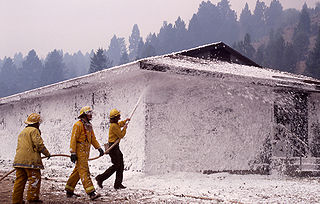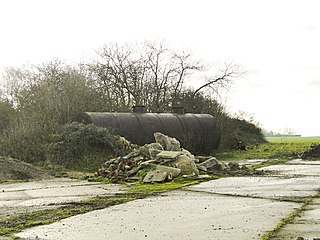Contamination is the presence of a constituent, impurity, or some other undesirable element that renders something unsuitable, unfit or harmful for both physical body, natural environment, workplace, etc.

Environmental remediation is the cleanup of hazardous substances dealing with the removal, treatment and containment of pollution or contaminants from environmental media such as soil, groundwater, sediment. Remediation may be required by regulations before development of land revitalization projects. Developers who agree to voluntary cleanup may be offered incentives under state or municipal programs like New York State's Brownfield Cleanup Program. If remediation is done by removal the waste materials are simply transported off-site for disposal at another location. The waste material can also be contained by physical barriers like slurry walls. The use of slurry walls is well-established in the construction industry. The application of (low) pressure grouting, used to mitigate soil liquefaction risks in San Francisco and other earthquake zones, has achieved mixed results in field tests to create barriers, and site-specific results depend upon many variable conditions that can greatly impact outcomes.

Radioactive contamination, also called radiological pollution, is the deposition of, or presence of radioactive substances on surfaces or within solids, liquids, or gases, where their presence is unintended or undesirable.
Human decontamination is the process of removing hazardous materials from the human body, including chemicals, radioactive substances, and infectious material.
Mass decontamination is the decontamination of large numbers of people, in the event of industrial, accidental, or intentional contamination by toxic, infective, caustic, polluted, or otherwise unhealthful or damaging substances.

Firefighting foam is a foam used for fire suppression. Its role is to cool the fire and to coat the fuel, preventing its contact with oxygen, thus achieving suppression of the combustion. Firefighting foam was invented by the Russian engineer and chemist Aleksandr Loran in 1902.
The RCA clean is a standard set of wafer cleaning steps which need to be performed before high-temperature processing steps of silicon wafers in semiconductor manufacturing.

Nanoscale iron particles are sub-micrometer particles of iron metal. They are highly reactive because of their large surface area. In the presence of oxygen and water, they rapidly oxidize to form free iron ions. They are widely used in medical and laboratory applications and have also been studied for remediation of industrial sites contaminated with chlorinated organic compounds.

A food contaminant is a harmful chemical or microorganism present in food, which can cause illness to the consumer.
Stripping is a physical separation process where one or more components are removed from a liquid stream by a vapor stream. In industrial applications the liquid and vapor streams can have co-current or countercurrent flows. Stripping is usually carried out in either a packed or trayed column.
Groundwater remediation is the process that is used to treat polluted groundwater by removing the pollutants or converting them into harmless products. Groundwater is water present below the ground surface that saturates the pore space in the subsurface. Globally, between 25 per cent and 40 per cent of the world's drinking water is drawn from boreholes and dug wells. Groundwater is also used by farmers to irrigate crops and by industries to produce everyday goods. Most groundwater is clean, but groundwater can become polluted, or contaminated as a result of human activities or as a result of natural conditions.
In situ chemical oxidation (ISCO), a form of advanced oxidation process, is an environmental remediation technique used for soil and/or groundwater remediation to lower the concentrations of targeted environmental contaminants to acceptable levels. ISCO is accomplished by introducing strong chemical oxidizers into the contaminated medium to destroy chemical contaminants in place. It can be used to remediate a variety of organic compounds, including some that are resistant to natural degradation. The in situ in ISCO is just Latin for "in place", signifying that ISCO is a chemical oxidation reaction that occurs at the site of the contamination.
A permeable reactive barrier (PRB), also referred to as a permeable reactive treatment zone (PRTZ), is a developing technology that has been recognized as being a cost-effective technology for in situ groundwater remediation. PRBs are barriers which allow some—but not all—materials to pass through. One definition for PRBs is an in situ treatment zone that passively captures a plume of contaminants and removes or breaks down the contaminants, releasing uncontaminated water. The primary removal methods include: (1) sorption and precipitation, (2) chemical reaction, and (3) reactions involving biological mechanisms.
In situ chemical reduction (ISCR) is a type of environmental remediation technique used for soil and/or groundwater remediation to reduce the concentrations of targeted environmental contaminants to acceptable levels. It is the mirror process of In Situ Chemical Oxidation (ISCO). ISCR is usually applied in the environment by injecting chemically reductive additives in liquid form into the contaminated area or placing a solid medium of chemical reductants in the path of a contaminant plume. It can be used to remediate a variety of organic compounds, including some that are resistant to natural degradation.

DeconGel is a gel created by CBI Polymers INC used to clean up after chemical and nuclear disasters. The product has been tested by numerous agencies and organizations in Japan including first responders, nuclear power plant operators, and private companies.
Nanoremediation is the use of nanoparticles for environmental remediation. It is being explored to treat ground water, wastewater, soil, sediment, or other contaminated environmental materials. Nanoremediation is an emerging industry; by 2009, nanoremediation technologies had been documented in at least 44 cleanup sites around the world, predominantly in the United States. In Europe, nanoremediation is being investigated by the EC funded NanoRem Project. A report produced by the NanoRem consortium has identified around 70 nanoremediation projects worldwide at pilot or full scale. During nanoremediation, a nanoparticle agent must be brought into contact with the target contaminant under conditions that allow a detoxifying or immobilizing reaction. This process typically involves a pump-and-treat process or in situ application.

Non-aqueous phase liquids, or NAPLs, are organic liquid contaminants characterized by their relative immiscibility with water. Common examples of NAPLs are petroleum products, coal tars, chlorinated solvents, and pesticides. Strategies employed for their removal from the subsurface environment have expanded since the late-20th century.
Dry decontamination is a method of removing contaminants without the need to use water or other liquids. Decontamination is an essential duty of hazmat responders as it protects victims from harmful reactions to the contaminants.

Hazmat diving is underwater diving in a known hazardous materials environment. The environment may be contaminated by hazardous materials, the diving medium may be inherently a hazardous material, or the environment in which the diving medium is situated may include hazardous materials with a significant risk of exposure to these materials to members of the diving team. Special precautions, equipment and procedures are associated with hazmat diving so that the risk can be reduced to an acceptable level.
Diving equipment may be exposed to contamination in use and when this happens it must be decontaminated. This is a particular issue for hazmat diving, but incidental contamination can occur in other environments. Personal diving equipment shared by more than one user requires disinfection before use. Shared use is common for expensive commercial diving equipment, and for rental recreational equipment, and some items such as demand valves, masks, helmets and snorkels which are worn over the face or held in the mouth are possible vectors for infection by a variety of pathogens. Diving suits are also likely to be contaminated, but less likely to transmit infection directly.









